Asphalt Optimizes BMX Speed, Smoothness
BY AsphaltPro Staff

Ridership at Lincoln Park BMX (bicycle motocross), a USA BMX-sanctioned track in Port Angeles, Washington, has increased 450% since President Sean Coleman took over in 2018. The track has been a part of the Port Angeles community since 1990, but was rebranded in 2018 to reflect the fresh start Coleman hoped to give the track.
“My son started racing in 2010 and my daughter started racing a year later,” Coleman said. Since his first day as president and track operator, Coleman strove to improve the track one element at a time.
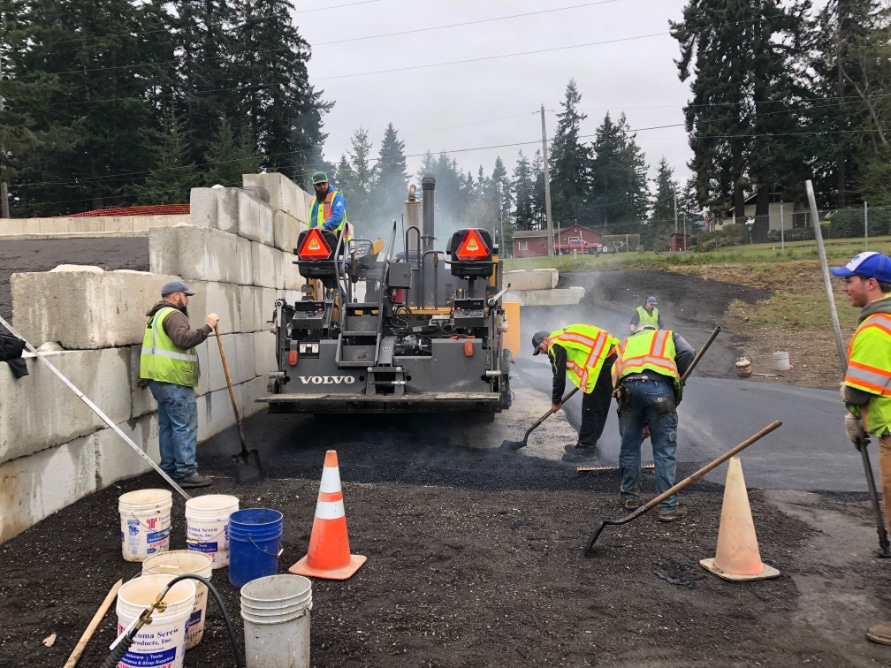
For the starting hill area, Lakeside was able to use its Caterpillar AP555 paver.
“When I took over, the track was in pretty bad shape,” Coleman said. The starting hill was falling apart and ridership had dropped off considerably. “We started off doing bits and pieces to improve the track each year. We added lights so we could run later, we started a track bike program with 60 used bikes and helmets the kids can use, and we paved the second and third corners of the track.”
Ultimately, the efforts of Coleman and the track’s volunteers paid off. “We were averaging 26 riders per race,” he said. “Now, we’re averaging 135 riders per race.” Then, in 2022, Lincoln Park BMX held its biggest event ever: the NW Gold Cup Finals, a national race of more than 1600 riders.
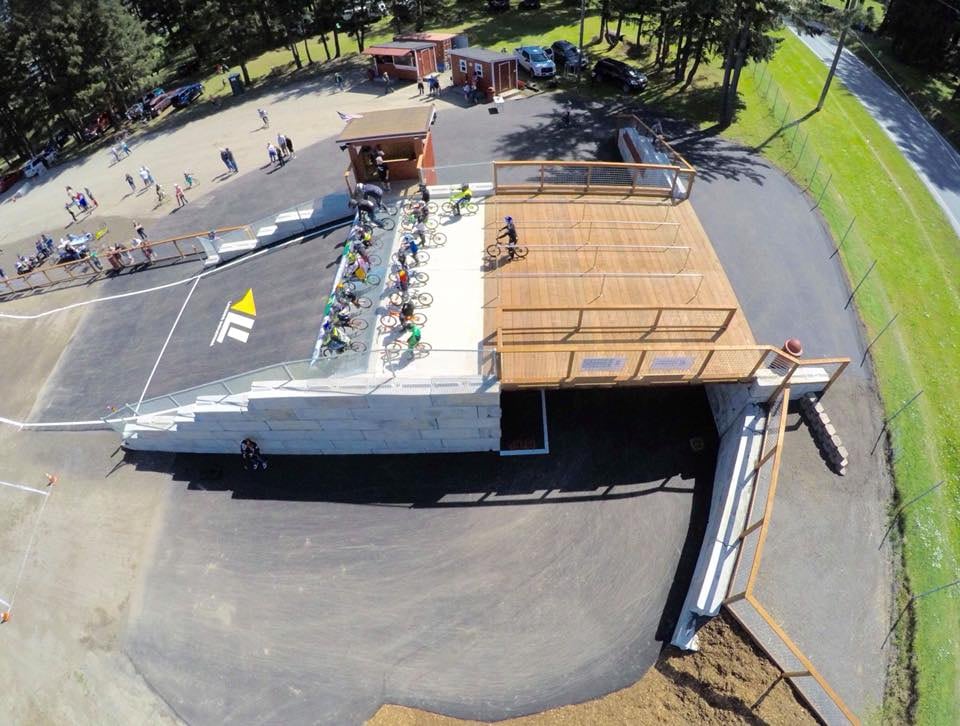
The starting hill, where racers begin the race each in their own gate area, was donated by Lakeside Industries and bears the company’s logo.
“We noticed during the race that the first corner wasn’t holding rider speed and some riders were even going over the top of the corner,” Coleman said. His work was not yet done. In 2023, Lincoln Park BMX received two grants for capital improvements totaling about $80,000 in the form of city and county lodging tax grants. Coleman hired a professional track builder to redesign the track and brought in the Olympic Peninsula Division of Lakeside Industries Inc., Port Angeles, Washington, to pave the starting hill and first corner. “Finally, we’ve been able to complete the whole vision.”
A New Challenge
Although Lakeside is no stranger to overcoming paving challenges, the Lincoln Park BMX track presented a new kind of challenge, said Division Operations Manager Bret McGuire. “We’ve done some technical work on custom driveways and such, but nothing has compared to this BMX track.”
Lakeside’s involvement at the track started off more than a decade ago when it paved one of the track’s corners, but many of its employees are involved in the track outside of work. “Their kids race, they donate their time to the track, etc.,” McGuire said. “I know they hold it near and dear to their hearts.”
Over the years, Lakeside has donated its labor and materials to several improvement projects at the track. “We’ve been out there five or six times on different projects over the past few years,” McGuire said.
“The support of our 50 or so volunteers has really helped us stretch every dollar,” Coleman said. “Lakeside has been a great supporter of the track. That’s why their logo is on the starting hill.”
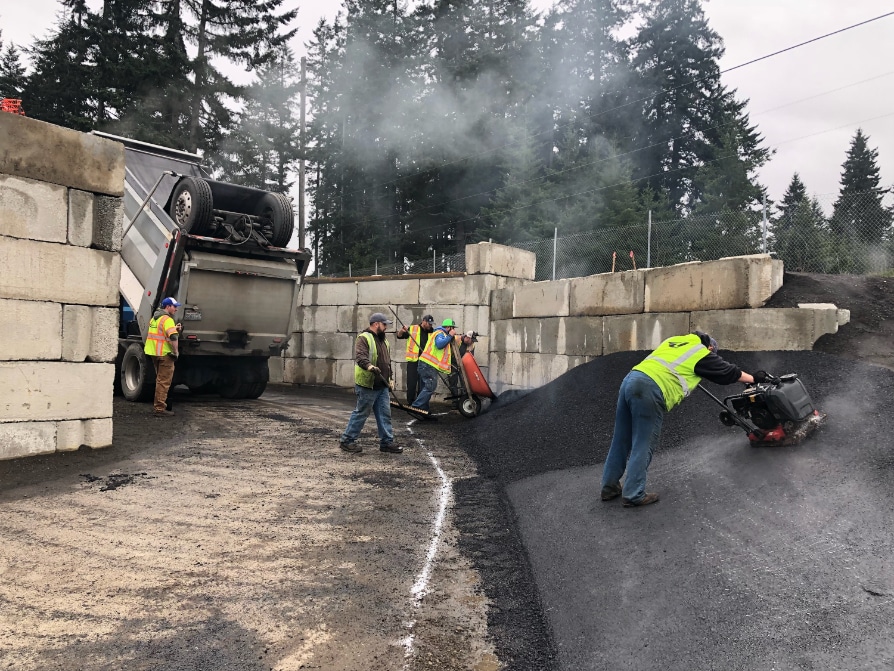
To compact the material in the corners, Lakeside’s crew used several Husqvarna LF75 plate compactors and worked their way from the bottom to the top to avoid pushing the asphalt downhill during compaction.
The starting hill is where racers begin the race, each in their own gate area. When the gates drop, the racers rush down the hill to build momentum to overcome the first jump. By making the starting hill asphalt, riders are able to increase speed from the start of the race.
“At the time, the track didn’t have the money, so we donated our time, material and equipment for that job,” McGuire said. “That got a lot of people involved and it just grew from there into additional projects.”
For that part of the project, Lakeside was able to use its Caterpillar AP555 paver and Cat CB24B and Beuthling B100 rollers. Another benefit of an asphalt starting hill—and asphalt corners—is that these improvements help keep the track maintained. This region of Washington receives around 35 to 40 inches of rain per year that increases the maintenance required on the track.
“Each corner requires about 8 to 10 hours of work each week to maintain,” Coleman said. “By paving the starting hill and corners, you’re doing way less maintenance. You’re not having to regrade it, pick rocks off, etc. It’s also a safer surface and adds better traction.”
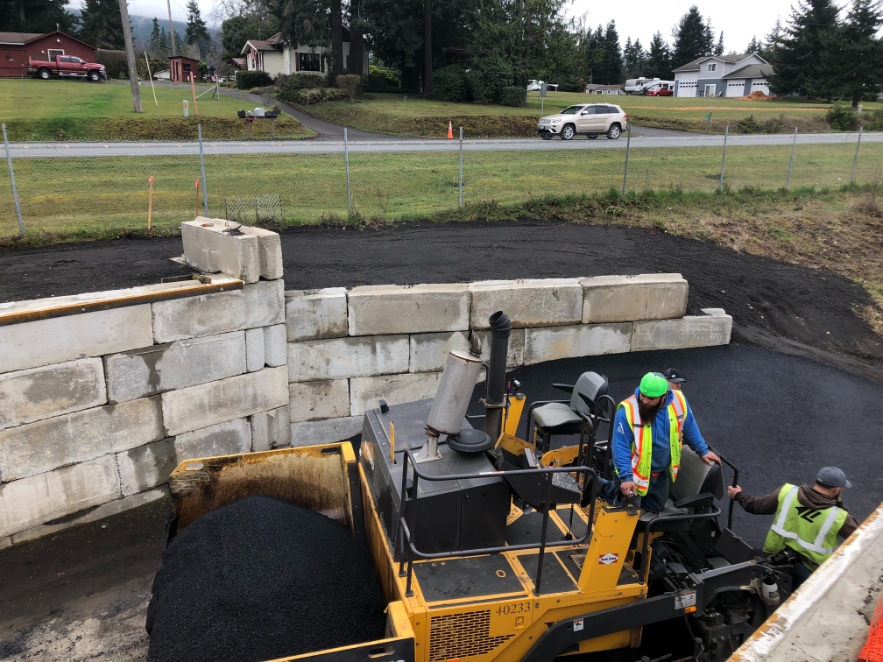
Graded for Racing
When the grants came in, Coleman knew he wanted to pave the track’s first corner and overlay its second corner. The third corner was still in good shape from the last time it was paved. But, before investing in these improvements, Coleman wanted to revamp the layout of the track.
“Up until this year, all the dirt work—the obstacles, the corners, everything—was done by volunteers, many of them from Lakeside,” Coleman said. “This year, we hired a professional track builder to design and build the track for us, including building up that first corner to be taller to help hold rider speed.”
How to Pave a Sport Court: Practice Really Does Make Perfect
The first step was demolishing the existing track (except the paved second and third corners), piling up the dirt and screening out any rocks that had made their way into the material over the years. “Every year, we’d change up the track with a new obstacle or improvement,” Coleman said. “But we were always mixing the dirt that was already out there, which meant we were always finding rocks in the material.”
To prepare for professional track builder, Lance McGuire of Dirttrendz in Oregon, to layout and grade the track, Lincoln Park BMX brought in 250 dump truck loads of new dirt to add to the screened material already on site. “Now we don’t have to fight rocks all the time,” Coleman said.
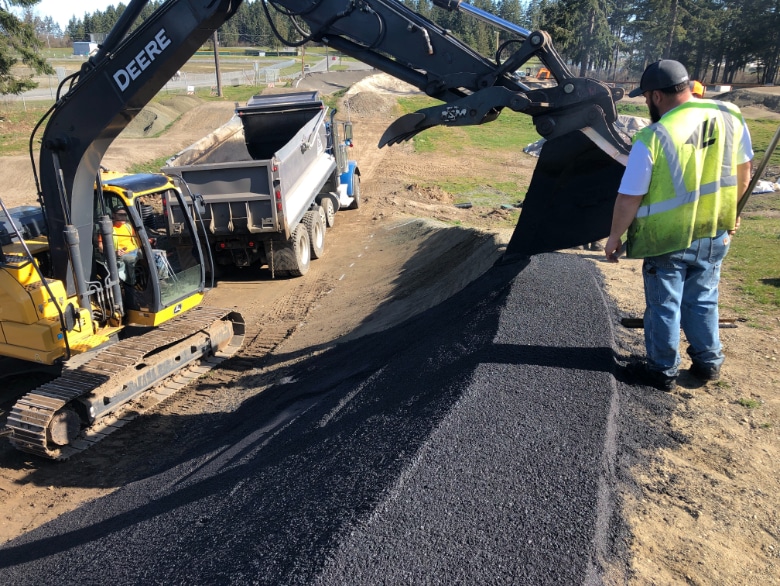
“The excavator seemed to work pretty well in getting the material to the top of the corners,” McGuire said. “We had to be really patient on this job and take it one bucket load at a time.”
The new design has also improved the technique of the course, Coleman added. “We tried to strike a balance between making the track enjoyable for both children and expert riders,” Coleman said, adding that the track’s oldest member is 75 years old. “At first, the kids didn’t like the new track because it’s a bit more technical, but a couple other tracks in Washington have recently become more technical, so the new track will help them compete with riders from those bigger tracks. And it’s definitely given them a home track advantage for the races we hold here.”
Add the Asphalt Corners
Once the track was graded and compacted, Lakeside’s crew came in to repave the second corner and pave the first corner.
“In some of the corners, there’s about a 10-foot height difference from top to bottom, in an arc ranging from a 30-degree angle at the bottom to nearly vertical at the top,” Coleman said. “It takes a lot to get that compacted.”
“The most challenging aspect of the project was the sheer steepness of the corners,” McGuire said. “That obviously added a new degree of difficulty getting the asphalt to the top of the corner and compacted. We had to come up with different means and methods to give them a good product.”
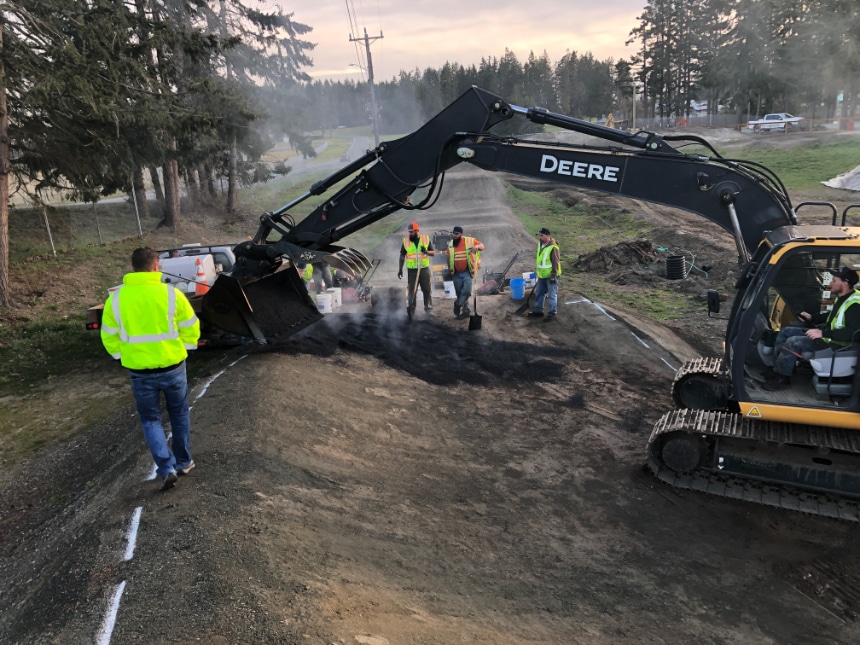
Lakeside used its John Deere 130P excavator to scoop asphalt out of the 17-ton Peterbilt truck assigned to this project and dump it onto the corner for the crew to work by hand and rake to the appropriate depth of 2 inches.
The first challenge was ensuring Lakeside would be able to bring its dump trucks close to the corners. “Because it was a reconstruction, we were able to get our truck in there,” McGuire said. “It wasn’t easy, but we did it.”
Next, Lakeside brought out its John Deere 130P excavator to scoop asphalt out of the 17-ton Peterbilt truck assigned to this project and dump it onto the corner for the crew to work by hand and rake to the appropriate depth of 2 inches. “The excavator seemed to work pretty well in getting the material to the top of the corners,” McGuire said. “We had to be really patient on this job and take it one bucket load at a time.”
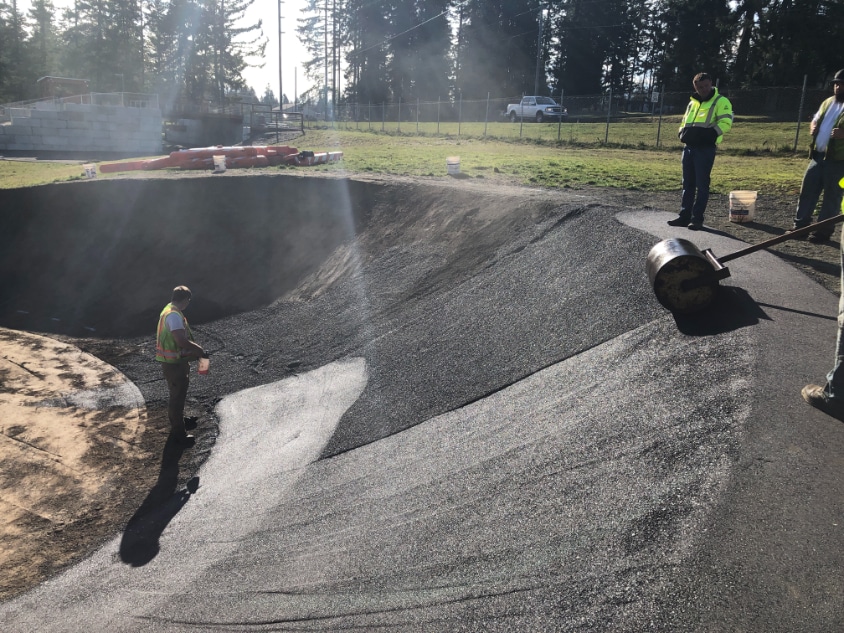
Not only will the asphalt corners and starting pad help the features remain as they were originally built, but they also increase the speed of the track.
To compact the material, Lakeside’s crew used several Husqvarna LF75 plate compactors and worked their way from the bottom of the corner to the top to avoid pushing the asphalt downhill during compaction.
“Once the bottom is compacted, you can walk on it as you start compacting your way up the slope” McGuire said. “When the corner starts to get steep, we tied a rope around the compactor and had a couple individuals standing at the top of the corner with one person on the slope operating the plate compactor and the others pulling the rope to help the compactor get up the slope.”
“With asphalt paving, we’re used to staying moving,” McGuire said. “With this, you place a bit and then wait for the compactors to catch up. It was a very time consuming and labor intensive process.”
One of McGuire’s tips for others paving BMX track features is to start on the easy stuff and work your way to the harder aspects of the job. “That way, you can get a feel for the placement process and material temperatures so you’re compacting it at the right temperature,” he said. “Ultimately, it’s not all that different from standard paving because it’s still all about timing.”
Thankfully, Lakeside didn’t feel a time crunch in terms of temperature. McGuire said the crew was grateful to have a dedicated haul truck on the project hauling mix from its Port Angeles plant located just five minutes from the project. “We were finishing about one truck load per hour,” McGuire said. “When they went to the plant for the next load, that gave us time to catch up with the compacting work.”
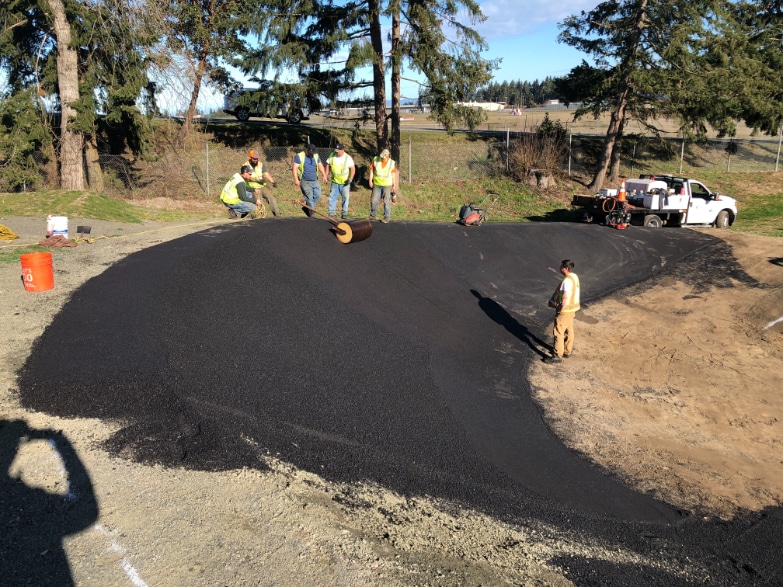
When the corner starts to get steep, Lakeside tied a rope around the compactor to help it get to the top of the slope.
Although this much manual manipulation of the material might raise segregation issues, McGuire said this wasn’t much of a concern since the traffic on these features will be primarily children on bikes. That’s also why they opted to use a finer ⅜-inch mix, chosen for its higher AC content, workability and smoothness. The job required a total of 80 tons for each corner.
“The only thing that can really happen is that things can settle out and move because you’re not getting really good compaction,” McGuire said. “There could be some settling or cracking as things shift and move, but we’ve had pretty good luck on the corner we paved 10 years ago. That’s still holding up nicely.”
Lakeside finished work on the remaining corners in August 2023. “I think they’ll be good for 10 or 15 years before they’ll need to be replaced or overlayed,” McGuire said.
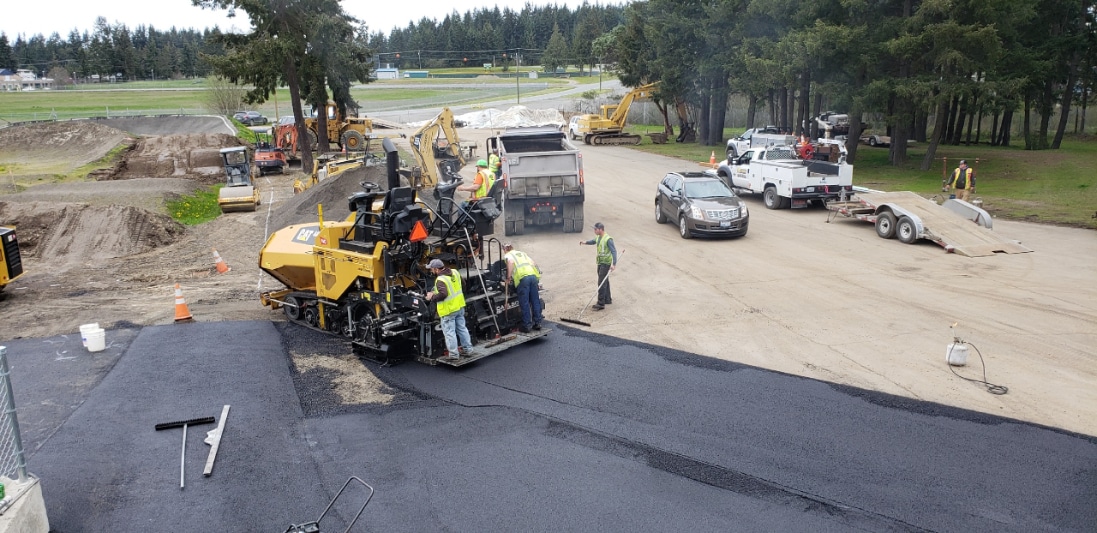
Need for Speed
Not only will the asphalt corners and starting pad help the features remain as they were originally built, but they also increase the speed of the track. “With the better traction our riders can get on those corners, they can achieve higher speeds,” Coleman said. The improved traction also allows riders to make passes more easily, he added. “Our riders love the paved corners. They’ve definitely increased the speed of the track and improved the technique of our riders. Out of all the paved corners in our state, I’d put ours at number one.”
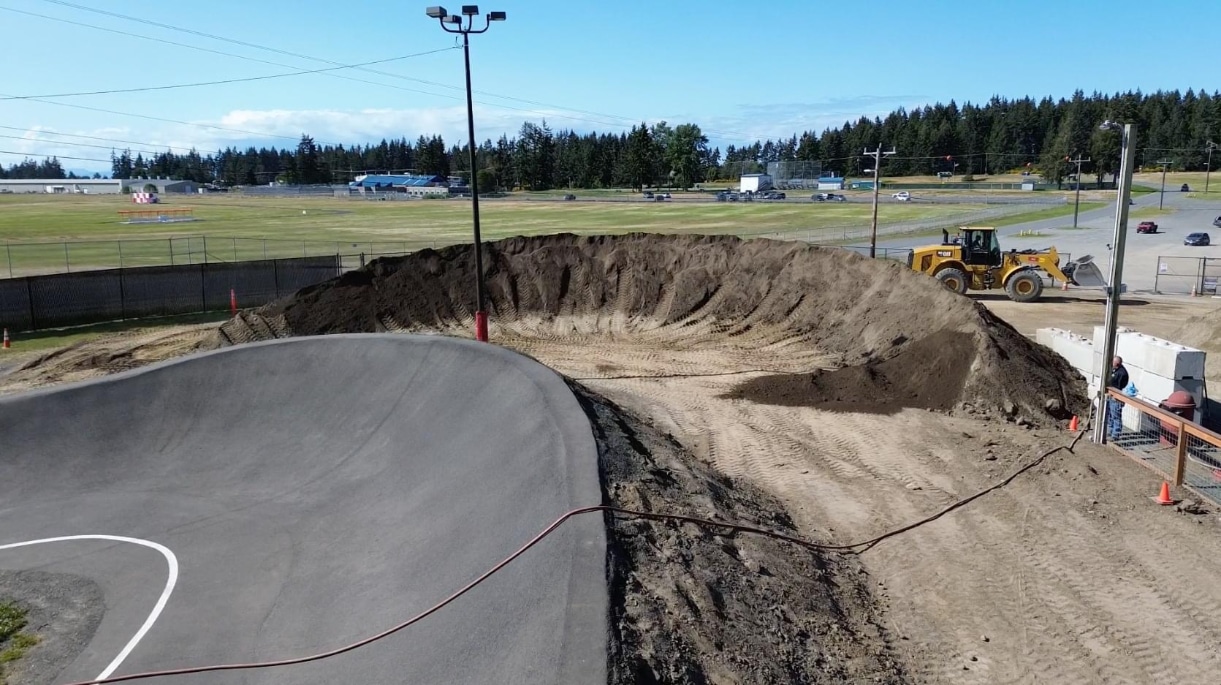
The final upgrades have enabled Lincoln Park BMX track to support bigger races and faster riders, such as the 2023 state finals that brought over 1100 riders for the weekend.
The final upgrades have also enabled Lincoln Park BMX to hold the 2023 state finals, which brought over 1100 riders for the weekend. “That really comes down to the caliber of the track,” Coleman said. Now, he added, Lincoln Park BMX track can support those bigger races and faster riders. “This is one of the top tracks in the state, maybe even the whole West Coast. And it’s almost all done by volunteers that want to see those kids have a place to be active. Whether a rider is 2 or 70, we’re all kids at heart, especially when we’re playing sports.”
Ultimately, the crew at Lakeside feels a similar sense of pride in the part they played in the improvements of the track. “It was a challenging project, but it’s so rewarding to see the benefit of our work when the kids get out there and race around,” McGuire said. “The people who make that track possible—not just our employees, but all the volunteers—really take a lot of pride in what they’ve built.”
